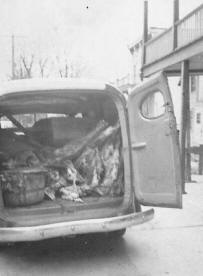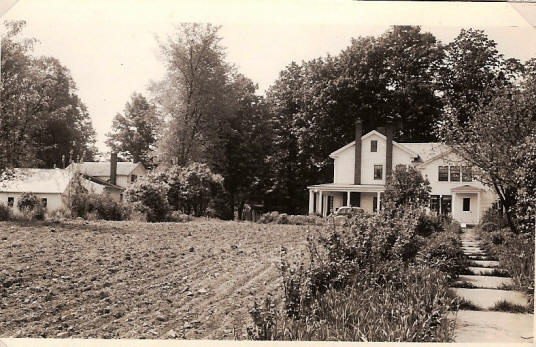|
|
|
Last time: From 1914-29, we hedged a bit before entering WWI…which we won…then played around in the Roaring 20s, but stumbled badly over a plummeting stock market. Chapter 22: The Great Depression, 1930-1939 Passionate Star Trek conventioneers who don Star Fleet uniforms and Spock ears and sing Klingon opera can recite the dialog verbatim from The City on the Edge of Forever. Even casual Trekkies know this Harlan Ellison inspired 1965 TV episode offers a good send-up of New York City soup lines of the Great Depression. The remastered DVD or even YouTube will take you to the streets of America in the early 1930s. While the news back then centered domestically on the staggering economy, high unemployment, and the Dust Bowl disaster, the people of Cambridge kept a daily eye on AP and UPI dispatches of the latest unrest in Europe and the Far East. But the United States refrained from the conflict for the moment. With city folk across the nation holding their breath, if not jumping from high rises, after the Crash of ’29, in the following weeks and months small farm-and-market towns like Cambridge were probably better prepared for the worst. The basics of food and shelter were part of the village’s infrastructure, and the residents were less dependent on the latest gadgets used by their urban cousins. McWhorter’s Market and Skellie’s delivery truck on the West End kept food on the table in the mid-30s, as did in-town chicken coops and gardens in the back lots tilled and harvested, like the one at 120 West Main in 1934 (see the photos).
As the calendar flipped to a new decade, NY Power & Light sought a permit to install gas lines about town for domestic fuel but the Village fathers declined. In 1932 Spear Consulting Engineering of Albany petitioned to have Cambridge acquire the private Water Company and construct a new system. The idea was also voted down to avoid the $115,000 charge. “Hey, we’re in a two year recession,” was the response. But also in ’32, Cambridge residents, seeking escape from increasingly depressing times, OK’d talkies on Sunday nights at the Fisher Playhouse on Main Street, at today’s A&M Printers. Perhaps the crowd was entertained by Grand Hotel, that year’s Oscar winner, with Greta Garbo, Joan Crawford, and Drew Barrymore’s Grandpappy John.
Firefighting in the early ‘30s was the responsibility of the official Cambridge Fire Department but was still assisted by some of the old private hose companies, hangers-on from the previous century. Finally disbanded in 1932, their members were absorbed into CFD creating a force of some 30 men, which rose to 40 by 1937. Mutual Aid was contracted with the Towns of Cambridge, Jackson and White Creek in 1939. In ‘35, the Village paid $75 for a used motorcycle for the town cop and the following year bought a new Indian Scout for $275. In 1938 Robert A. Scott was hired as the first Cambridge attorney. The mayor’s seat in the 1930s was filled by Earl Shaw, two 2-year terms; Jim Robertson, one term; Robert Burns, once (likely not the reincarnated 18th century poet); and Bill Robertson who, from 1937-44, led Cambridge out of the Great Depression and through the civic sacrifices of WWII. During the 1930s, Cambridge High School continued to graduate future leading Village citizens, 249 total in the decade. Familiar names include many who lived into advanced age and left a lasting mark on Cambridge culture in a variety of important capacities: teacher Evelyn Holden (Class 1930); publisher Gardner Cullinan (’31, see the CCS Alumni website for his remarkable bio); farmer Ben English and housewife Marcia Clark Raymond (’34); businessman Charley Ackley (’36); grocer Ed McMorris (’38). Each career was, and is, as vital to the very lifeblood of the Cambridge District as the next. With the national recession hard to kick and moving toward depression, Prohibition was becoming increasingly unfavorable across the land, not the least of which was due to crime and enforcement costs. Repeal of the 18th Amendment of 1919 gained support and legal booze eased its way back with the Cullen-Harrison Act. Signed by President Franklin D. Roosevelt in March 1933, it allowed the sale of wine and 3.2% beer, thought less intoxicating and less prone to domestic abuse, the driving motivation by the Temperance ladies in the first place. By late ‘33 the 48 states ratified the 21st Amendment which cancelled the 18th. The intervening Constitutional laws? The 19th finally gave women the right to vote (1920), and the 20th in early 1933 moved the Presidential Inauguration from March 4, since the days of the Founders, to January 20. Federal alcohol enforcement laws were also repealed but the issue lived on jurisdictionally until 1966, with Mississippi the last state hold out. People still needed jobs, and FDR and his administration went to work to put them back to work through fireside chats and new deals. They created a host of alphabet soup programs: CCC, WPA, FDIC, TVA, FHA, SEC. Subject to intense infighting between liberals and conservatives, many passed legal tests despite the government intrusion. Some yielded lasting success through construction of facilities like the National Park lodges across the West, dams spanning canyons and bridges across rivers and bays. You’ve seen those little bridges over troubled waters, over creeks and brooks scattered around the American countryside with a “1933” or a “1937” cast into their concrete pillars. And we know how Social Security got its start as a safety net, but apparently with little thought to ever paying the piper. Other New Deal line items were deemed unconstitutional over the years and tossed out. By 1938, the worst of the Depression was yesterday’s worries. On October 30 of that year America was startled to learn that Martians were invading a NJ marsh not far from NYC. Actor and filmmaker Orson Welles adapted H. G. Wells' 1898 novel The War of the Worlds for airing by CBS in a radio drama that appeared to present live breaking news. Panic ensued in the nation’s streets … or not, depending on whom you believe. But the program's news format was described as “cruelly deceptive” by newspapers and public figures, leading to an outcry against the producers of the show. The grandkids of the outraged might consider today’s main media and network TV’s skewed political reportage. The 1938 episode launched Welles' career. Back to The City on the Edge of Forever and the mean streets of New York: By way of a time portal, an accidental drug overdose, and a fleeting romance, this Sci-Fi classic offers two tracks for what could emerge out of the 1930s, recorded history and horrific fiction. The main character visited by the crew of the Enterprise, Edith Keeler, is a soup kitchen manager and persuasive world peace visionary, and the object of Capt. James T. Kirk’s affection. The parallel timeline drags America along a path of widespread pacifist movement which delays our entry into WWII long past December 1941. This allows Nazi Germany to beat us to the bomb and Hitler proceeds to conquer 20th century Earth with his nuclear tipped V2s. You’ll have to watch the episode to see how it all gets untangled, but gladly for our reality, when the Third Reich invaded Poland on September 1, 1939, the United States took only two short years before jumping into the fray, to turn history along the course we know. It’s said that modern “American Exceptionalism”, a term coined recently, was born out of the Great Depression. It can be summed up with a classic quote contrasted to another, separated by a few years but divided by a gulf. On one shore reside the ideals of the Founders, on the other those of an apparent stranger to the nature of America: “There are no constraints on the human mind, no walls around the human spirit, no barriers to our progress except those we ourselves erect.” (Ronald Wilson Reagan, 1985) “Look, if you’ve been successful, you didn’t get there on your own.” (Barack Hussein Obama, 2012) This odd bit of wisdom followed yet another presidential proclamation announced on the world stage in 2009: “We’ve been arrogant, dismissive, even derisive.” Students of U.S. history, civics and culture are left to wonder how the American character is so blithely blown off. How does one equate government assistance, like President Roosevelt’s of the 1930s, with private capitalism? Equate rising out of an abyss with scaling a mountain? How can one compare bureaucratic bailouts to the private sector drive that gives us chip-scale logic and the web, better houses, cars, jets, toothpaste, designer jeans and designer genes? Such initiative was forged, such moral fiber woven by the settlers of the Cambridge Patent of 1761. And throughout the Colonies, after considerable bloodshed, the Founders fashioned a law to protect the individual and limit the Feds, a chapter in America’s story that fired up the entrepreneurs of the 19th century Industrial Revolution. In Cambridge in 1798, this birthed a free press (the Northern Centinel, forbear of the WC Post), and yielded J.B. Rice’s vision for a seed company built over a swamp a century later. More recently, Bob McWhorter called for a modern grocery on West Main, Jimmy Estramonte’s sweet tooth opened an ice cream parlor on the East End, and Donnie Schneider drafted a plan for a machine shop out in Coila, each motivated only by opportunity and driven only by sweat, by smart business plans with slender profit margins, private profits. None gave a nod to “spread the wealth” on demand by vote-pandering, freebie doling politicians. Help the indigent? Of course. Freely given philanthropy? Certainly. But “Don’t Tread on Me” plays as well in the Owlkill as it does in New Hampshire. Recall how our acclaimed battle craft got its name, whether the USS Enterprise (CVN 65), our first e=mc2 powered carrier now in its sunset cruise after 50 years on the line defending against tyranny; or the warp drive propelled starship USS Enterprise (NCC1701), four centuries in the future, where crass class-warfare–-“you do poorly because I do well”–-no longer exists on an M-class planet called Earth. Private enterprise is the grace, guts, and glory of the United States, not some socialist manifesto fashionable in France, Venezuela or faculty lounges. Jane’s Fighting Ships doesn’t list a USS Redistribution. Honest Americans also know that the most industrious and generous nation in the annals of man—since we pulled ourselves up by the bootstraps in the ‘30s—needn’t apologize for our presence around the globe. Wise voters with unrevised U.S. history in the memory banks will reply: “Speak for yourself, Sir, and not for 250 years you had absolutely nothing to do with, lessons you obviously missed at Punahou School.” President Roosevelt never apologized for America during the 1930s. Indeed, on December 8, 1941, a day after those Sunday morning murders—including civilians just miles from Punahou—he did quite the opposite. He called out the dogs to clean up the mess wrought by the Neville Chamberlains and Charles Lindbergs of the day; once good men, they died in controversy (the P.M.), if not oblivion (the pilot). History offers their ilk only a shrug to footnote that they’ll never rank among the mid-20th century generation that let us “Live long and prosper” … so far. Today their legacy is at risk. The Founders, who wrote, fought and died for freedom, and the Greatest Generation, who also served and bled for liberty—including many listed on the plaques in the Cambridge Memorial Park—deserve far better than today’s feckless post-modern “American Acquiescence.” Next time: Chapter 23, “Global Warfare and a New Peace, 1940-1949”: American Exceptionalism matures. Sources: Cambridge Village Archives; CCS Alumni Assn. (www.ccsindians.com); Raymond family archives; Biography of Col. Robert R. Raymond (1871-1944), Thomas M. Raymond © 2010. (Contact the author at tmraymond4@gmail.com.) |
|
CAMBRIDGE HISTORY LIVES © 2011
|




